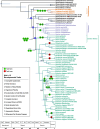Fossil-calibrated molecular clock data enable reconstruction of steps leading to differentiated multicellularity and anisogamy in the Volvocine algae
- PMID: 38600528
- PMCID: PMC11007952
- DOI: 10.1186/s12915-024-01878-1
Fossil-calibrated molecular clock data enable reconstruction of steps leading to differentiated multicellularity and anisogamy in the Volvocine algae
Abstract
Background: Throughout its nearly four-billion-year history, life has undergone evolutionary transitions in which simpler subunits have become integrated to form a more complex whole. Many of these transitions opened the door to innovations that resulted in increased biodiversity and/or organismal efficiency. The evolution of multicellularity from unicellular forms represents one such transition, one that paved the way for cellular differentiation, including differentiation of male and female gametes. A useful model for studying the evolution of multicellularity and cellular differentiation is the volvocine algae, a clade of freshwater green algae whose members range from unicellular to colonial, from undifferentiated to completely differentiated, and whose gamete types can be isogamous, anisogamous, or oogamous. To better understand how multicellularity, differentiation, and gametes evolved in this group, we used comparative genomics and fossil data to establish a geologically calibrated roadmap of when these innovations occurred.
Results: Our ancestral-state reconstructions, show that multicellularity arose independently twice in the volvocine algae. Our chronograms indicate multicellularity evolved during the Carboniferous-Triassic periods in Goniaceae + Volvocaceae, and possibly as early as the Cretaceous in Tetrabaenaceae. Using divergence time estimates we inferred when, and in what order, specific developmental changes occurred that led to differentiated multicellularity and oogamy. We find that in the volvocine algae the temporal sequence of developmental changes leading to differentiated multicellularity is much as proposed by David Kirk, and that multicellularity is correlated with the acquisition of anisogamy and oogamy. Lastly, morphological, molecular, and divergence time data suggest the possibility of cryptic species in Tetrabaenaceae.
Conclusions: Large molecular datasets and robust phylogenetic methods are bringing the evolutionary history of the volvocine algae more sharply into focus. Mounting evidence suggests that extant species in this group are the result of two independent origins of multicellularity and multiple independent origins of cell differentiation. Also, the origin of the Tetrabaenaceae-Goniaceae-Volvocaceae clade may be much older than previously thought. Finally, the possibility of cryptic species in the Tetrabaenaceae provides an exciting opportunity to study the recent divergence of lineages adapted to live in very different thermal environments.
Keywords: Ancestral state reconstruction; Cellular differentiation; Fossil calibration; Molecular clock; Multicellularity; Phylogeny; Volvocine algae.
© 2024. The Author(s).
Conflict of interest statement
The authors declare that they have no competing interests.
Figures




Similar articles
-
Phylotranscriptomics points to multiple independent origins of multicellularity and cellular differentiation in the volvocine algae.BMC Biol. 2021 Aug 31;19(1):182. doi: 10.1186/s12915-021-01087-0. BMC Biol. 2021. PMID: 34465312 Free PMC article.
-
Evolution of cytokinesis-related protein localization during the emergence of multicellularity in volvocine green algae.BMC Evol Biol. 2017 Dec 6;17(1):243. doi: 10.1186/s12862-017-1091-z. BMC Evol Biol. 2017. PMID: 29212441 Free PMC article.
-
A Reinvestigation of Multiple Independent Evolution and Triassic-Jurassic Origins of Multicellular Volvocine Algae.Genome Biol Evol. 2023 Aug 1;15(8):evad142. doi: 10.1093/gbe/evad142. Genome Biol Evol. 2023. PMID: 37498572 Free PMC article.
-
Evolution of reproductive development in the volvocine algae.Sex Plant Reprod. 2011 Jun;24(2):97-112. doi: 10.1007/s00497-010-0158-4. Epub 2010 Dec 21. Sex Plant Reprod. 2011. PMID: 21174128 Free PMC article. Review.
-
Co-option during the evolution of multicellular and developmental complexity in the volvocine green algae.Curr Opin Genet Dev. 2016 Aug;39:107-115. doi: 10.1016/j.gde.2016.06.003. Epub 2016 Jul 2. Curr Opin Genet Dev. 2016. PMID: 27379901 Review.
Cited by
-
Genetic Predisposition Toward Multicellularity in Chlamydomonas reinhardtii.Genome Biol Evol. 2025 May 30;17(6):evaf090. doi: 10.1093/gbe/evaf090. Genome Biol Evol. 2025. PMID: 40380887 Free PMC article.
-
Multicellularity and increasing Reynolds number impact on the evolutionary shift in flash-induced ciliary response in Volvocales.BMC Ecol Evol. 2024 Sep 14;24(1):119. doi: 10.1186/s12862-024-02307-1. BMC Ecol Evol. 2024. PMID: 39277710 Free PMC article.
-
Plasticity and the evolution of group-level regulation of cellular differentiation in the volvocine algae.Proc Biol Sci. 2025 Mar;292(2043):20242477. doi: 10.1098/rspb.2024.2477. Epub 2025 Mar 19. Proc Biol Sci. 2025. PMID: 40103550 Free PMC article.
References
-
- Maynard Smith J, Szathmáry E. The major transitions in evolution. Oxford University Press; 1995.
-
- Lamża Ł. Diversity of ‘simple’ multicellular eukaryotes: 45 independent cases and six types of multicellularity. Biol Rev. 2023;brv.13001. - PubMed
MeSH terms
Grants and funding
LinkOut - more resources
Full Text Sources

